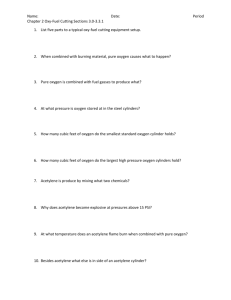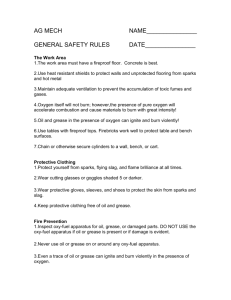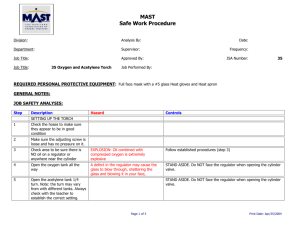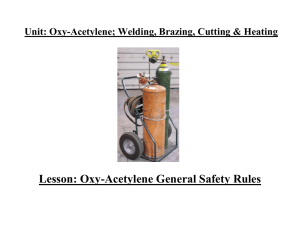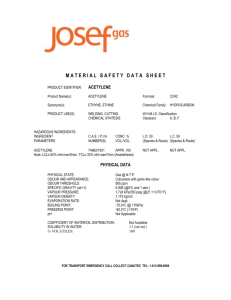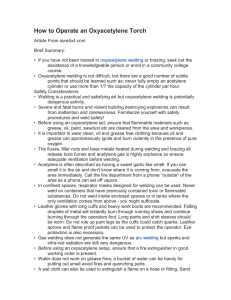Oxyacetylene Welding (OAW)
advertisement
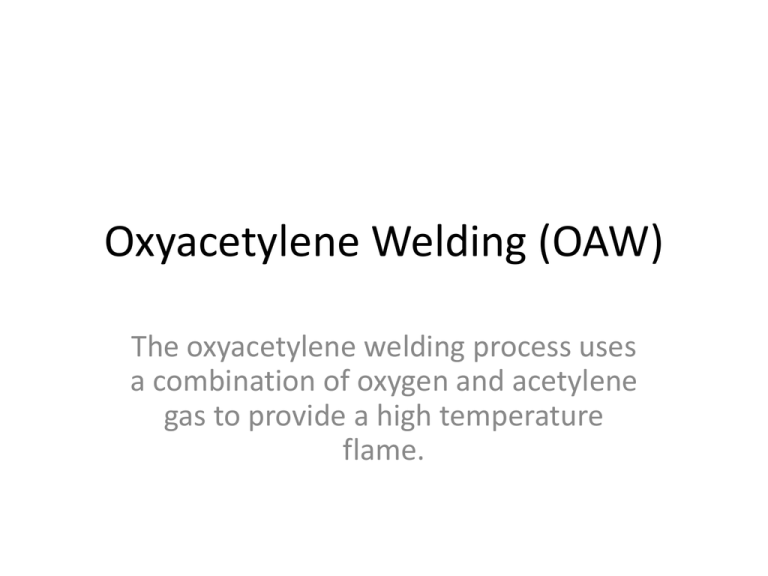
Oxyacetylene Welding (OAW) The oxyacetylene welding process uses a combination of oxygen and acetylene gas to provide a high temperature flame. Oxyacetylene Welding (OAW) • OAW is a manual process in which the welder must personally control the the torch movement and filler rod application • The term oxyfuel gas welding outfit refers to all the equipment needed to weld. • Cylinders contain oxygen and acetylene gas at extremely high pressure. Typical Oxyacetylene Welding (OAW) Station Oxygen Cylinders • Oxygen is stored within cylinders of various sizes and pressures ranging from 2000- 2640 PSI. (Pounds Per square inch) • Oxygen cylinders are forged from solid armor plate steel. No part of the cylinder may be less than 1/4” thick. • Cylinders are then tested to over 3,300 PSI using a (NDE) hydrostatic pressure test. Oxygen Cylinders • Cylinders are regularly re-tested using hydrostatic (NDE) while in service • Cylinders are regularly chemically cleaned and annealed to relieve “jobsite” stresses created by handling . Cylinder Transportation • Never transport cylinders without the safety caps in place • Never transport with the regulators in place • Never allow bottles to stand freely. Always chain them to a secure cart or some other object that cannot be toppled easily. Oxygen Cylinders • Oxygen cylinders incorporate a thin metal “pressure safety disk” made from stainless steel and are designed to rupture prior to the cylinder becoming damaged by pressure. • The cylinder valve should always be handled carefully Pressure Regulators for Cylinders • Reduce high storage cylinder pressure to lower working pressure. • Most regulators have a gauge for cylinder pressure and working pressure. Pressure Regulators for Cylinders • Regulators are shut off when the adjusting screw is turn out completely. • Regulators maintain a constant torch pressure although cylinder pressure may vary • Regulator diaphragms are made of stainless steel Pressure Regulators Gauges Using a “Bourdon” movement • Gas entering the gauge fills a Bourdon tube • As pressure in the semicircular end increases it causes the free end of the tube to move outward. • This movement is transmitted through to a curved rack which engages a pinion gear on the pointer shaft ultimately showing pressure. Regulator Hoses • Hoses are are fabricated from rubber • Oxygen hoses are green in color and have right hand thread. • Acetylene hoses are red in color with left hand thread. • Left hand threads can be identified by a grove in the body of the nut and it may have “ACET” stamped on it Check Valves & Flashback Arrestors • Check valves allow gas flow in one direction only • Flashback arrestors are designed to eliminate the possibility of an explosion at the cylinder. • Combination Check/ Flashback Valves can be placed at the torch or regulator. Acetylene Gas • Virtually all the acetylene distributed for welding and cutting use is created by allowing calcium carbide (a man made product) to react with water. • The nice thing about the calcium carbide method of producing acetylene is that it can be done on almost any scale desired. Placed in tightly-sealed cans, calcium carbide keeps indefinitely. For years, miners’ lamps produced acetylene by adding water, a drop at a time, to lumps of carbide. • Before acetylene in cylinders became available in almost every community of appreciable size produced their own gas from calcium carbide. Acetylene Cylinders • Acetylene is stored in cylinders specially designed for this purpose only. • Acetylene is extremely unstable in its pure form at pressure above 15 PSI (Pounds per Square Inch) • Acetone is also present within the cylinder to stabilize the acetylene. • Acetylene cylinders should always be stored in the upright position to prevent the acetone form escaping thus causing the acetylene to become unstable. Acetylene Cylinders • Cylinders are filled with a very porous substance “monolithic filler” to help prevent large pockets of pure acetylene form forming • Cylinders have safety (Fuse) plugs in the top and bottom designed to melt at 212° F (100 °C) Acetylene Valves • Acetylene cylinder shut off valves should only be opened 1/4 to 1/2 turn • This will allow the cylinder to be closed quickly in case of fire. • Cylinder valve wrenches should be left in place on cylinders that do not have a hand wheel. Oxygen and Acetylene Regulator Pressure Settings • Regulator pressure may vary with different torch styles and tip sizes. • PSI (pounds per square inch) is sometimes shown as PSIG (pounds per square inch -gauge) • Common gauge settings for cutting – 1/4” material Oxy 30-35psi Acet 3-9 psi – 1/2” material Oxy 55-85psi Acet 6-12 psi – 1” material Oxy 110-160psi Acet 7-15 psi • Check the torch manufactures data for optimum pressure settings Regulator Pressure Settings • The maximum safe working pressure for acetylene is 15 PSI ! Typical torch styles • A small welding torch, with throttle valves located at the front end of the handle. Ideally suited to sheet metal welding. Can be fitted with cutting • attachment in place of the welding head shown. Welding torches of this general design are by far the most widely used. They will handle any oxyacetylene welding job, can be fitted with multiflame (Rosebud) heads for heating applications, and accommodate cutting attachments that will cut steel 6 in. thick. • A full-size oxygen cutting torch which has all valves located in its rear body. Another style of cutting torch, with oxygen valves located at the front end of its handle. Typical startup procedures • Verify that equipment visually appears safe IE: Hose condition, visibility of gauges • Clean torch orifices with a “tip cleaners” (a small wire gauge file set used to clean slag and dirt form the torch tip) • Crack (or open) cylinder valves slightly allowing pressure to enter the regulators slowly • Opening the cylinder valve quickly will “Slam” the regulator and will cause failure. Typical startup procedures • Never stand directly in the path of a regulator when opening the cylinder • Check for leaks using by listening for “Hissing” or by using a soapy “Bubble” solution • Adjust the regulators to the correct operating pressure • Slightly open and close the Oxygen and Acetylene valves at the torch head to purge any atmosphere from the system. Typical startup procedures • Always use a flint and steel spark lighter to light the oxygen acetylene flame. • Never use a butane lighter to light the flame Flame Settings • There are three distinct types of oxy-acetylene flames, usually termed: – Neutral – Carburizing (or “excess acetylene”) – Oxidizing (or “excess oxygen” ) • The type of flame produced depends upon the ratio of oxygen to acetylene in the gas mixture which leaves the torch tip. Pure Acetylene and Carburizing Flame profiles Neutral and Oxidizing Flame Profiles Inert Gases • Argon, helium, nitrogen, and carbon dioxide • Form a protective envelope around the weld area • Used in – MIG – TIG – Shield Metal Arc Vacuum • Produce high-quality welds • Used in electron beam welding • Nuclear/special metal applications – Zr, Hf, Ti • Reduces impurities by a factor of 20 versus other methods • Expensive and time-consuming Weld Fluxes • Typical fluxes – SiO2, TiO2, FeO, MgO, Al2O3 – Produces a gaseous shield to prevent contamination – Act as scavengers to reduce oxides – Add alloying elements to the weld – Influence shape of weld bead during solidification


